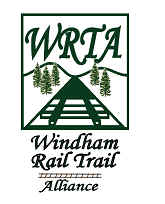
Windham Rail Trail Alliance
Windham Rail Trail Alliance |
|
| Trail BackgroundDuring
2003, the State of
The Granite State Rail Trail/Rockingham Trail - WindhamThis 4.1 Mile section starts from the intersection of Routes 111 and 28 in Salem continuing to a point on North Lowell Road, Windham. The Windham Depot serves as the base for parking. To the north the trail connects to the Derry Rail Trail which provides for 4 miles of a continuous paved trail and combines for 8 miles of the longest paved abandoned rail corridor in the state. This section of rail-bed was used as a multi-purpose trail for about the past 18 years managed by NH Department of Resources and Economic Development. As of September 3, 2003 legislation was passed which prohibits OHRV use as well Federal regulations restrict OHRV use on trails purchased by Transportation Enhancement Grants. The parking lot in Windham is open from 1/2 hour before to 1/2 hour after sunset. This is a scenic stretch of trail which passes though beautiful shaded ledges, two pond marshes and predominately wooded and shaded. There are 3 bridges that the trail crosses. The only road crossings are at Windham Depot and Roulston Rd. There is also an historic New Hampshire granite archway built in 1849 that provides a unique architectural significance. A lengthy ledge cut provides a cool section of passing on hot days, and in the winter forms beautiful ice flow "sculptures." The trail passes several stonewalls and a cellar hole from an 1800 sawmill. The Windham Depot buildings and surrounding town property has been designated a historic district by the Town of Windham in 2003. The Depot building and freight storage building remain intact, and were rehabilitated through a Transportation Enhancement grant in 2010. With the infamous C-16 caboose and restored parking area the Depot site brings a unique trail experience to our users.
Our MissionFrom our Articles of Incorporation: Purpose The purpose of this
corporation is to raise funds through charitable means that will allow it to
provide on-going stewardship, preservation, and the promotion and
education of the 4.1 historical miles of the Rockingham Multiuse Trail from
Route 111A in Windham, New Hampshire to a point on North Lowell Road in the same
town, as it is managed as a paved Rail to Trail bike path
within the meaning
of Section of the Internal Revenue Code, or corresponding sections of
any federal future tax code. Through its
activities the corporation will provide to the public a premier non-motorized
recreational and educational experience by use of the paved trail and
rehabilitation of the historical buildings located at the Windham Depot.
|
|
|